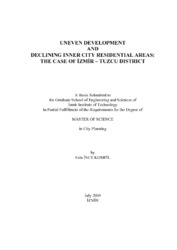Please use this identifier to cite or link to this item:
https://hdl.handle.net/11147/3441| Title: | Uneven development and declining inner city residential areas: The case of Izmir-Tuzcu District | Authors: | İnce Kompil, Esin | Advisors: | Avar, Adile | Publisher: | Izmir Institute of Technology | Abstract: | Izmir, being the third largest city of Turkey has experienced rapid urbanization after 1950s and especially after 1980s. Similar to the other metropolitan cities of Turkey, İzmir presents a dual structure including the growing and declining parts of the city. Within the conceptual framework of uneven development, the thesis examines the decline process of inner residential areas of İzmir in the case of Tuzcu District (a central district) by presenting current structure of the district and comparing with the past. The theory of uneven development is one of the foremost approaches to explain the recent changes and the transformations occurring in cities within the Marxist paradigm. Capital accumulation processes and class relations have an essential role in the process of uneven development of cities. The city or built environment itself is commodified by the capital since the capital moves through the built environment itself in search of returns across an uneven and changing ground-rent surface. In the capitalist system, the main purpose of the capitalists is to gain profit by investing property in the city, where it provides the maximum returns. So with the effects of movement of capital within the built environment, some parts of the city develop while the other parts decline. This unevenness is very common for all capitalist cities in the developed countries. As a part of the dual structure of cities, the phenomenon of urban decline is discussed widely in developed countries. On the other hand, the phenomenon of urban decline is relatively new for Turkey as well as in other developing countries compared to the developed countries. In Turkey, the process of urbanization of capital had begun particularly at 1980s and this continuing period has more striking patterns of uneven development in urban areas on account of the increasing hegemony of capital on urbanization process. It is certain that the capital had inevitably been one of the main diagnostic elements of initial urbanization process in Turkey. In this framework, the phenomenon of inner city residential decline is examined using the concept of deprivation as a methodological tool. The deprivation level of Tuzcu District is measured in terms of both material and social aspects. Finally, general features of Tuzcu District as a declining area have presented comparing with the developed countries in terms of poverty, unemployment, segregation, decline of physical environment, disinvestments and economic decline, decline of public education, and health. | Description: | Thesis (Master)--Izmir Institute of Technology, City and Regional Planning, Izmir, 2005 Includes bibliographical references (leaves: 98-101) Text in English; Abstract: Turkish and English viii, 106 leaves |
URI: | http://hdl.handle.net/11147/3441 |
| Appears in Collections: | Master Degree / Yüksek Lisans Tezleri Sürdürülebilir Yeşil Kampüs Koleksiyonu / Sustainable Green Campus Collection |
Files in This Item:
| File | Description | Size | Format | |
|---|---|---|---|---|
| T000410.pdf | MasterThesis | 1.87 MB | Adobe PDF |  View/Open |
CORE Recommender
Page view(s)
166
checked on Nov 18, 2024
Download(s)
66
checked on Nov 18, 2024
Google ScholarTM
Check
Items in GCRIS Repository are protected by copyright, with all rights reserved, unless otherwise indicated.